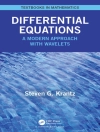An accessible guide to developing intuition and skills for
solving mathematical problems in the physical sciences and
engineering
Equations play a central role in problem solving across various
fields of study. Understanding what an equation means is an
essential step toward forming an effective strategy to solve it,
and it also lays the foundation for a more successful and
fulfilling work experience. Thinking About Equations
provides an accessible guide to developing an intuitive
understanding of mathematical methods and, at the same time,
presents a number of practical mathematical tools for successfully
solving problems that arise in engineering and the physical
sciences.
Equations form the basis for nearly all numerical solutions, and
the authors illustrate how a firm understanding of problem solving
can lead to improved strategies for computational approaches. Eight
succinct chapters provide thorough topical coverage, including:
* Approximation and estimation
* Isolating important variables
* Generalization and special cases
* Dimensional analysis and scaling
* Pictorial methods and graphical solutions
* Symmetry to simplify equations
Each chapter contains a general discussion that is integrated
with worked-out problems from various fields of study, including
physics, engineering, applied mathematics, and physical chemistry.
These examples illustrate the mathematical concepts and techniques
that are frequently encountered when solving problems. To
accelerate learning, the worked example problems are grouped by the
equation-related concepts that they illustrate as opposed to
subfields within science and mathematics, as in conventional
treatments. In addition, each problem is accompanied by a
comprehensive solution, explanation, and commentary, and numerous
exercises at the end of each chapter provide an opportunity to test
comprehension.
Requiring only a working knowledge of basic calculus and
introductory physics, Thinking About Equations is an
excellent supplement for courses in engineering and the physical
sciences at the upper-undergraduate and graduate levels. It is also
a valuable reference for researchers, practitioners, and educators
in all branches of engineering, physics, chemistry, biophysics, and
other related fields who encounter mathematical problems in their
day-to-day work.
Table of Content
Preface.
Acknowledgments.
List of Worked-Out Example Problems.
1 Equations Representing Physical Quantities.
1.1 Systems of Units.
1.2 Conversion of Units.
1.3 Dimensional Checks and the Use of Symbolic Parameters.
1.4 Arguments of Transcendental Functions.
1.5 Dimensional Checks to Generalize Equations.
1.6 Other Types of Units.
1.7 Simplifying Intermediate Calculations.
Exercises.
2 A Few Pitfalls and a Few Useful Tricks.
2.1 A Few Instructive Pitfalls.
2.2 A Few Useful Tricks.
2.3 A Few ‘Advanced’ Tricks.
Exercises.
3 Limiting and Special Cases.
3.1 Special Cases to Simplify and Check Algebra.
3.2 Special Cases and Heuristic Arguments.
3.3 Limiting Cases of a Differential Equation.
3.4 Transition Points.
Exercises.
4 Diagrams, Graphs, and Symmetry.
4.1 Introduction.
4.2 Diagrams for Equations.
4.3 Graphical Solutions.
4.4 Symmetry to Simplify Equations.
Exercises.
5 Estimation and Approximation.
5.1 Powers of Two for Estimation.
5.2 Fermi Questions.
5.3 Estimates Based on Simple Physics.
5.4 Approximating Definite Integrals.
5.5 Perturbation Analysis.
5.6 Isolating Important Variables.
Exercises.
6 Introduction to Dimensional Analysis and Scaling.
6.1 Dimensional Analysis: An Introduction.
6.2 Dimensional Analysis: A Systematic Approach.
6.3 Introduction to Scaling.
Exercises.
7 Generalizing Equations.
7.1 Binomial Expressions.
7.2 Motivating a General Expression.
7.3 Recurring Themes.
7.4 General yet Simple: Euler’s Identity.
7.5 When to Try to Generalize.
Exercises.
8 Several Instructive Examples.
8.1 Choice of Coordinate System.
8.2 Solution Has Unexpected Properties.
8.3 Solutions in Search of Problems.
8.4 Learning from Remarkable Results.
Exercises.
Index.
About the author
Matt A. Bernstein, Ph D, is Professor of Radiologic Physics
at the Mayo Clinic, where he holds appointments in the Departments
of Radiology and Biomedical Engineering. A Fellow of the
International Society for Magnetic Resonance in Medicine (ISMRM)
and Editorial Board member of Magnetic Resonance in
Medicine, Dr. Bernstein has published over sixty journal
articles, mainly in the field of MRI physics.
William A. Friedman, Ph D, is Emeritus Professor at the
University of Wisconsin and Affiliate Professor at the University
of Washington. A Fellow of the American Physical Society, Dr.
Friedman has over forty years of academic experience and has
authored more than one hundred journal articles in the field of
nuclear physics.












